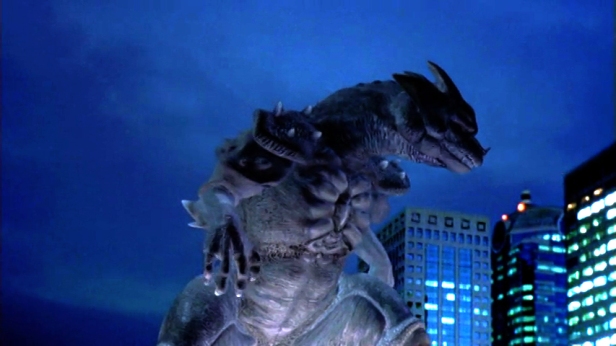Three decade after the release of South Korea’s first giant monster film, Taekoesu Yonggary (1967), director Shim Hyung-rae felt that the time was right for a remake – possibly because Roland Emmerich’s US version of Godzilla had been released just the year before. Bizarrely, the new film goes to extraordinary lengths to distance itself from its Korean roots; it’s set in Los Angeles (no-one in the film ever mentions this fact but we see the city named on a cop’s badge), is entirely full of American and British actors, the dialogue was recorded in English and there’s barely an Asian face to be seen anywhere in the entire film. Having one eyes on the overseas markets is one thing, but this takes it to whole new levels.
An archaeological party exploring some caverns discovers the fossilised remains of a huge dinosaur like creature. Two years later, an alien spacecraft arrives in orbit around the Earth and starts destroying American satellites and space shuttles for no discernible reason. The aliens then reanimate the dinosaur with a powerful beam of light. Dubbed Yonggary (it’s “fifty times the size of T-Rex”) after an ancient Korean legend, the creature starts rampaging around the city, battling trigger-happy military forces that cause more collateral damage than Yongarry is able to do on its own. There’s some behind-the-mayhem shenanigans involving corrupt politicians, mad scientists and nuke-happy generals that no-one is at all bothered about before Yongarry is freed of the control that the aliens have over it by the Project T Force, a platoon of troops that zoom around on high powered jet packs. Enraged, the aliens send another monster, Cyker (or Cykor, no-one seems to be able to agree on how it’s pronounced) to take out Yongarry who has switched its allegiance to the side of the humans. A cut price computer generated monster-on-monster smack down ensues before Yongarry emerges triumphant.

That’s what happens in the film as you’ll find it disc or streaming services today, but it wasn’t always that way. In 2001, after the film had been a hit at the box office, Shim Hyung-rae returned to the film, added whole new sequences (the original cut had ended with the military defeating Yongarry – Cyker is a freshly minted creature for this version), new CGI effects and additional characters. It was a critical and commercial flop when it was released to Korean cinemas under the title Yonggary: 2001 Upgrade Edition and to home video in the West as Reptilian but it’s currently the only version you can see.
The “upgraded”version under review here is a showcase for some hilariously bad acting, terrible effects and even worse dialogue (“If that thing were any meaner I’d swear it was my wife”). The script by Park Hui-jun is almost insultingly bad. His dialogue sounds like the work of an enthusiastic high-schooler who was so impressed by the first draft of his first screenplay that he simply turned it in unedited and uncorrected. It takes a full 35 minutes before Yongarry shows up, leaving us with the dreary archaeologists and macho military types for company, and when it does finally show up Park has no idea what to do with it other than make it copy everything that Godzilla, Gamera and the rest had already done so many times before.

Once he gets going, Yongarry’s city-smashing antics are plentiful if poorly realised. The special effects really are lousy, neither of the two monsters being lit in a way that makes them look like they actually belong in the background plates into which they’ve been inserted. The designs of the monsters are fine, particularly Cyker, but the shoddy effects make them both look like cartoon characters that have wandered in from another film. Given better effects, the big action scenes might have been spectacular, though no amount of top notch digital work was ever going to prevent Project T Force, a troop of lunkheads flying around on jetpacks from looking completely ridiculous. They’re also the most inept military force you could never wish to meet – when ordered to hit the diamond shaped receiver on Yongarry’s forehead, these idiots spend ages shooting at just about anything other than the very thing that will stop the monster’s rampage.
So cheap that the producers were forced to use the same shots of buildings blowing up over and over again, Yongarry is, in its own special way, even worse than the 1967 original. The story is long-winded and often makes no sense, the effects are shockingly bad and the pathetic metallic puppet aliens need to be seen to be disbelieved. “This can’t be happening,” protests one character. “No! Isn’t real!” screams another. Sorry chaps, it is – you’ll wish it wasn’t but there’s no escaping the fact that this astonishing, outlandish kaiju misfire is out there praying for more Godzilla revivals so that it can drag its sorry self back into the reflected limelight one more time. Don’t be fooled – there are plenty of Godzilla films to enjoy before you start abusing yourself with this garbage.